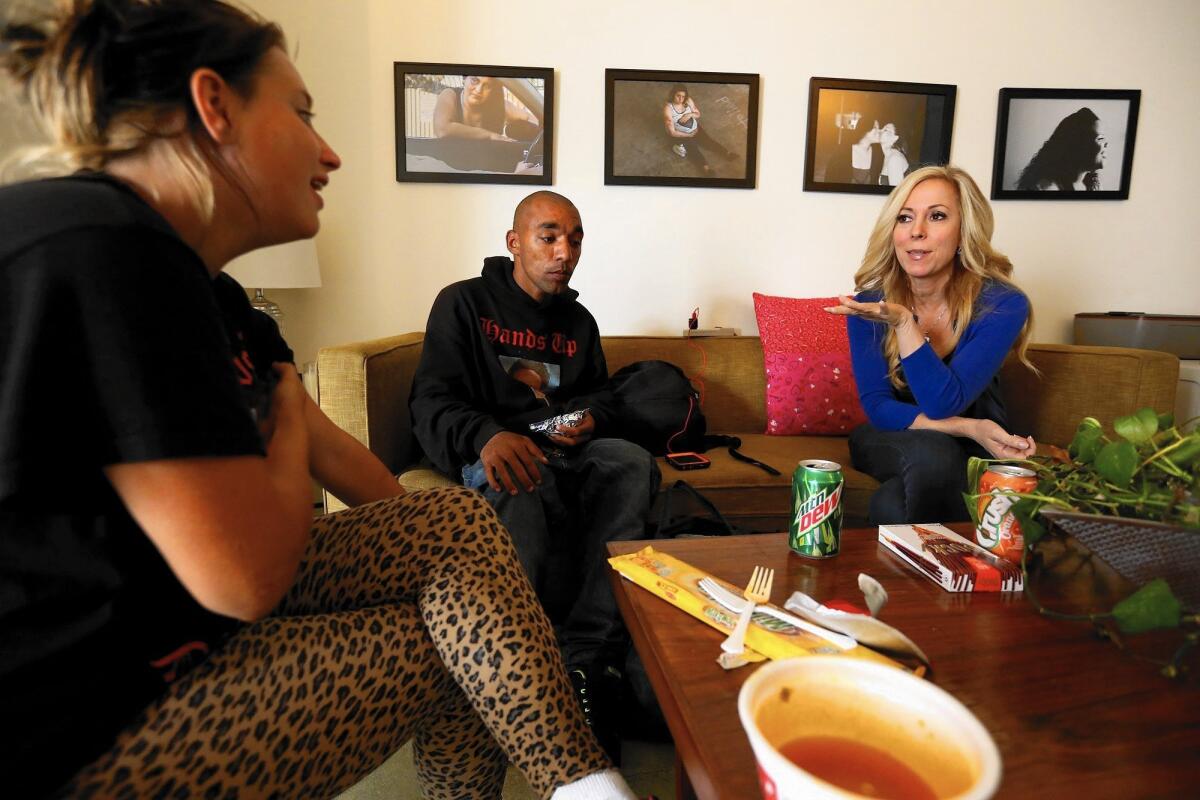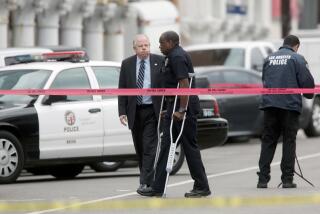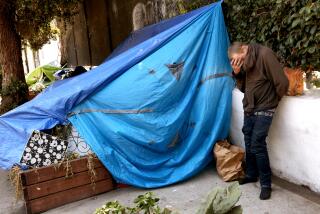Homeless man’s death underscores grim reality of travelers’ lifestyle

Tina Marie Church, 19, left, and her boyfriend Timothy Truman, 23, talk with Lauri Burns, founder of The Teen Project. Church and Truman are both homeless and living in Venice.
At The Teen Project’s drop-in center on the Venice boardwalk, young people come and go all day. It’s been a haven for hundreds of vagabonds and runaways who flock to the beach from all across the country.
In three years, the center’s counselors have steered more than 150 teens and young adults away from street life and toward stability.
Brendon Glenn, 29, was supposed to be one of them.
He visited the center on the evening of May 5 and asked for help getting home to his family in New York. He was tired, tearful and probably drunk. Counselors planned to call his mother the next morning; she didn’t know her son had become a beach bum.
Several hours later, after he scuffled with a bar bouncer and a couple of cops, Glenn was shot to death near the drop-in center by a Los Angeles Police Department officer.
His death led to a series of vigils, a heated community meeting and online face-offs between people sympathetic to the “urban travelers” who congregate at the beach and those who blame the young “crusties” for ruining the neighborhood’s famous live-and-let-live vibe.
In what seems like a fitting tribute, Glenn’s death has sparked a flurry of requests for help from young men who don’t find life on the boardwalk much fun anymore.
“After Brendon died, a lot of these kids were desperate to get off the street,” said Lauri Burns, founder of The Teen Project and a fixture at the center.
They may tout their freedom and camaraderie — camping on the beach, partying, panhandling to eat — but the sudden death of one of their own has brought the downside of the travelers’ lifestyle into sharp relief.
“You’re sleeping on the ground. You’re dirty, there’s nowhere to wash, there are bugs in your hair,” Burns said. “You get beaten up by gang members who steal your money, your skateboard, whatever you have. People don’t even look at you, or they look at you with disgust.
“These kids come for the sunshine and hippie life, then the reality hits. It starts to look not so nice.”
::
Burns understands the forces that strand young people on the streets.
“Every step these kids are going to hit, I hit myself,” she said, ticking them off: runaway, homeless, pregnant, drug addict, prostitute.
“The message to me, and for a lot of these kids, is nobody cares about you.”
Burns’ life took a turn for the better in 1987, when a Vietnam vet rescued her from a beating by johns, took her in and nudged her toward sobriety at age 23. She landed a scholarship to a residential treatment center for women and a grant that paid for six months of technical school.
That put her on a path that led to 15 years working as a technology manager at Northrop-Grumman. She bought a home and began taking in foster teenagers, then realized that at 18, they would be on their own, just as she had been.
Determined to help, Burns and a co-worker developed a national shelter directory that homeless kids could tap into by texting the word “shelter.” In 2007, she and a friend pooled their money to create an Orange County program for girls who had aged out of foster care.
“It started as this tiny little charity project,” Burns said.”We had tons of volunteers, but we didn’t have a name, so we just called it that teen project.”
By 2008, The Teen Project had raised enough money to buy a place in Lake Forest and turn it into a six-bedroom home for young women moving from foster care to college. In 2012, it added the Venice drop-in center, which connects young people to job training and counseling and provides temporary housing in private homes for those with nowhere else to go.
“Ninety percent of these kids have a safe relative they can return to,” Burns said. “An uncle, a brother, a grandpa.... They just need someone to broker the deal.”
Her project’s newest venture, launched last year, is a 100-bed residential treatment program in Sun Valley “for girls who are addicts, prostitutes, homeless — everything I once was.”
::
Most of the street kids in Venice are from somewhere else. That’s made their presence a sore point for many residents and business owners. But others see past that.
Two days after Glenn died, his friends held a sidewalk memorial. Venice real estate broker Tami Pardee paid for the snacks and balloons — then offered to foot the bill to house any kid ready to leave the boardwalk.
Thirteen hands went up; that cost her $17,000. She’d been prepared to spend even more.
Pardee is a mother of four. “And if these were my kids, coming out to Venice and thinking they’re going to live the dream, I’d want somebody to help send them home,” she said. “We live here, we work here, we all ought to take a role in this.”
There are signs that may be happening.
City Councilman Mike Bonin has enlisted business owners, civic leaders and social service agencies to share information and pool resources to better meet the needs of transient kids.
A drop-in center run by the nonprofit Safe Place for Youth offers medical care and mental health counseling.
And LAPD Chaplain Steve Weller makes twice-weekly forays to talk with people living on the streets; he offers them shelter beds or a bus ticket back to their hometowns.
Weller, a pastor at Venice Foursquare Church, has raised $5,000 and found shelter beds or family help for more than 70 people who’d been living near the beach, said Mark Ryavec, president of the Venice Stakeholders’ Assn.
Ryavec’s group is suing the city and county, alleging they’ve allowed the area around the boardwalk to be overrun with transients, creating a public nuisance. “It’s simple to want to feed them and give them blankets,” he said. “That’s not what Venice needs.”
Twitter: @SandyBanksLAT
More to Read
Sign up for Essential California
The most important California stories and recommendations in your inbox every morning.
You may occasionally receive promotional content from the Los Angeles Times.











